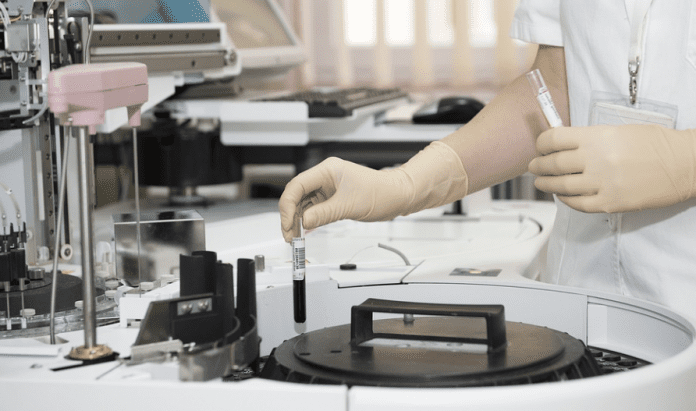Last Updated on April 28, 2024 by Umer Malik
Table of Contents
Definition of HPLC Columns
High-performance liquid chromatography (HPLC) columns are tools used to separate and identify components of a sample. HPLC Columns is used in a variety of industries, including pharmaceuticals, environmental sciences, biotechnology, and food science.
A typical HPLC consumables consists of a stainless steel tube filled with packing material. The packing material can be either a solid or liquid phase or both. The solid phase is usually made from small particles such as silica gel, polystyrene beads, or alumina; the liquid phase can be either water-soluble or organic solvent-soluble materials such as polymers and surfactants. The size and shape of the particles vary depending on the purpose for which the column is being used; for example, larger particles may be better suited for separating large molecules while smaller particles are better suited for separating smaller molecules.
The stationary phase in an HPLC column serves two primary functions: it provides surface area for sample components to interact with and it acts as a filter that allows some components to pass through while blocking others from passing through into the mobile phase. Depending on their properties, some compounds will interact more strongly with one type of stationary phase than another type.
Types of HPLC Columns
High-Performance Liquid Chromatography (HPLC) is one of the most widely used analytical techniques in chemistry and biochemistry. HPLC is a powerful tool for separating, analyzing, and quantifying compounds. To maximize the efficiency of HPLC analysis, it is important to select an appropriate column for each application. Each type of HPLC column has its own set of characteristics that make it better suited for particular types of analyses.
The two main types of columns used in HPLC are reverse-phase columns and normal-phase columns. Reverse-phase columns are the most common type used in modern laboratories and are ideal for separating hydrophobic molecules with high efficiency and resolution. These columns contain a layer or stationary phase composed mainly of hydrophobic polymers such as polystyrene or polyethylene glycols which interact preferentially with hydrophobic molecules over polar molecules such as water or alcohols.
Normal-phase columns are less commonly used than reverse-phaser due to their lower efficiency but they offer unique advantages when separations require high selectivity or separation on nonpolar analytes including organometallics, fatty acids, carotenoids, etc… Normal-phase columns consist of stationary phase coated.
Benefits of HPLC Columns
High-Performance Liquid Chromatography (HPLC) columns are essential components of HPLC systems and play an important role in the separation, purification, and analysis of a wide variety of samples. HPLC columns provide a means to quickly isolate compounds in complex mixtures by using different stationary phases to interact with the molecules being analyzed.
HPLC columns offer many advantages over other forms of chromatography such as gas chromatography (GC). One advantage is that HPLC can separate compounds based on their size, shape, and charge, which allows for more precise separations. Additionally, because the sample is injected into the column at high pressure (up to 600 bar), it is possible to achieve faster separations than with GC. Furthermore, since detectors are used after each fraction elutes from the column, it is possible to accurately detect and quantify trace amounts of analytes present in samples.
Another benefit of using HPLC columns is that they can be easily customized for specific applications. Different stationary phases can be chosen depending on what type of separation needs to be achieved (e.g., reversed-phase or normal phase).
Factors to Consider When Purchasing an HPLC Column
When it comes to choosing an HPLC column for your laboratory, there are many factors to consider. These include the type of analysis you’ll be performing, the resolution and speed you need, and the compatibility with any existing instrumentation. To help you make an informed decision when purchasing an HPLC column for your laboratory, here are some key considerations that should be taken into account.
First and foremost is the type of analysis you will be performing with your HPLC column. Different columns are designed for different applications so it’s important to choose a column that is compatible with your particular needs. For example, if you plan on using it for reversed-phase separations then a C18 or C8 bonded phase column would be best suited for that task. It’s also important to consider what types of compounds will be analyzed as this could have implications on which solvent system should be used in combination with the chosen column as well as what kind of detection system should accompany it.
The resolution and speed at which separation can occur is another key factor when selecting an HPLC column; higher resolution means better separation but could also result in longer run times due to increased back pressure requirements while faster runs may yield poorer results due to reduced band.
Conclusion
In conclusion, HPLC columns are essential components of an HPLC system and play an important role in the efficient separation of complex samples. They can be used for a variety of applications, from small molecules to proteins and peptides. With their wide range of stationary phases, chemistries, and pore sizes, HPLC columns offer many advantages over traditional chromatographic techniques. As technology continues to evolve, so too will the range of available HPLC columns.
Apart from this, if you are interested to know about health insurance in India then visit our Health category.
















